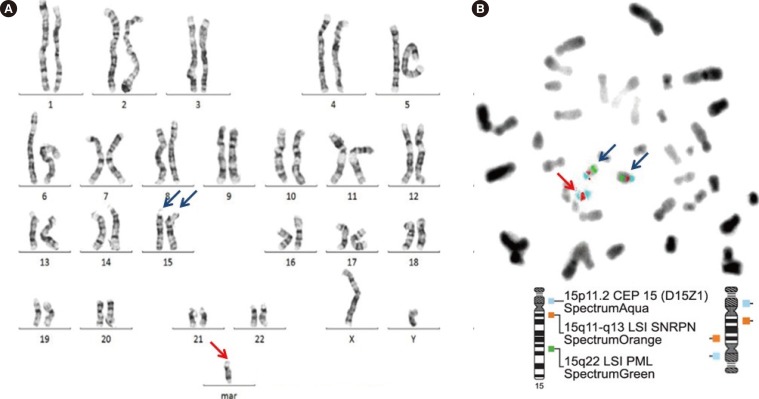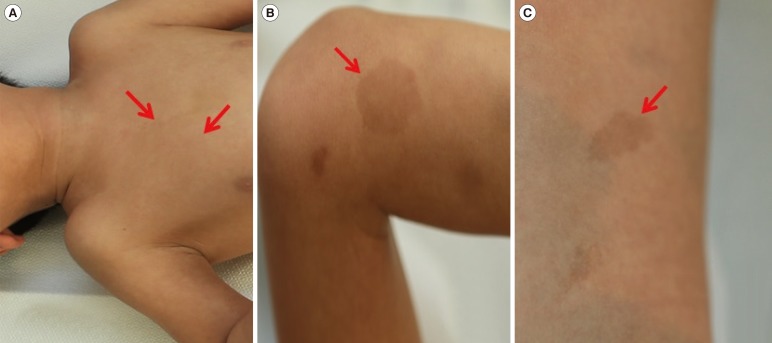 | Fig. 2(A) The G-banded karyotype of the patient. Trypsin-Giemsa banded chromosome analysis at the 550-band level shows a marker chromosome, which is suspected to be isodicentric chromosome 15 (red arrow). A normal chromosome 15 pair is present (blue arrows). (B) Interphase FISH using the Vysis LSI tricolor SNRPN probe set (Abbott). Two aqua signals for the 15p11.2 (CEP 15) probe and one orange signal for the 15q11-q13 (SNRPN) probe indicate the presence of isodicentric chromosome 15 with region q13 affected (red arrow). The normal chromosome 15 pair shows one aqua signal, one orange signal, and one green signal (15q22, PML; blue arrows). |
Dear Editor
Isodicentric chromosome 15 [idic(15) or inv dup(15)] syndrome is a rare condition with distinctive clinical features, including developmental delay, hypotonia, epilepsy, and autism or autistic-like behavior [1]. These features can obscure a definitive diagnosis, which can only be obtained by chromosomal analysis. In a review of the types and incidence of marker chromosomes at a university hospital in Korea, there was a report on a patient that presented idic(15) along with various other marker chromosomes [2]. Recently, two additional cases of idic(15) syndrome in Korea were published in reports focusing on their specific phenotypes [3, 4]. We present a Korean patient with delayed development and café-au-lait spots, a novel associated phenotype, who was diagnosed with idic(15) syndrome.
A 3-yr-old boy was referred to our hospital for evaluation of delayed development and multiple, large café-au-lait spots. He was born full term by normal vaginal delivery. The patient had no history or family history of seizure. He was a second child, and his older brother showed normal development. He showed developmental delay in speech and motor functions, which were estimated to be one year behind the reference milestones assessed by the Bayley Scales of Infant Development. Physical examination revealed multiple café-au-lait spots (3-10 cm) on the right hemitrunk, upper extremity, lower extremity, and neck (Fig. 1). Minor craniofacial dysmorphisms involving mildly deep-set eyes, downslanting palpebrae, and microcephaly were also observed.
Although the first impression was neurofibromatosis (NF) type 1 based on the café-au-lait spots, chromosome analysis using standard trypsin-Giemsa banding showed an abnormal karyotype 47,XY,+idic(15)(q13) (Fig. 2A). To confirm the abnormality, FISH was performed with a locus-specific identifier (LSI) probe set for SNRPN (Abbott Molecular/Vysis, Downers Grove, IL, USA), which is the causal region of Prader-Willi/Angelman syndrome. Two aqua signals and one orange signal indicated the presence of an isodicentric chromosome 15 with region q13 affected (Fig. 2B). Parental chromosome analyses were not available because of their refusal. At publication, no epileptic events had occurred, and conservative care with physical and speech-language therapy has been administered.
Epilepsy is considered to be the most significant medical concern in patients with idic(15) syndrome. Therefore, several studies have focused on the types of seizures and treatment options [5]. It is recommended that patients with idic(15) syndrome and clinicians be aware of the increased risk for seizures, which highlights the importance of accurate diagnosis of idic(15) syndrome by medical geneticists.
Another interesting clinical phenotype of idic(15) syndrome is autism or autistic-like behavior [6]. Chromosome region 15q11-q13 has been widely investigated for its instability and high susceptibility to genomic rearrangements [1], and there are several reports of autism spectrum disorder in patients with chromosome 15 abnormalities, which supports the notion that the long arm of chromosome 15 is an autism candidate region [6, 7]. Although our patient did not show signs of autistic behavior, the development of autism should be monitored carefully since the emergence of some autistic features may be delayed.
The most important clinical presentation in our patient was the multiple, large café-au-lait spots. Café-au-lait spots are traditionally regarded as the definitive sign of NF type 1, and their significance has been continuously validated [8]. Interestingly, there have been recent reports on the spectrum of diseases that can manifest multiple café-au-lait spots, especially in correlation with genetic abnormalities [9]. Our case suggests that café-au-lait spots could be the most remarkable abnormality in idic(15) syndrome, even though it is rarely reported. There was a recent report on a Cuban girl diagnosed as having idic(15) syndrome with a periumbilical café-au-lait spot [10], which supports the opinion that significant, abnormal skin manifestations should be carefully evaluated in relation to idic(15) syndrome. Our finding suggests that idic(15) syndrome should also be considered along with other syndromes currently associated with multiple, large café-au-lait spots [8], such as NF type 1, Noonan syndrome, and McCune-Albright syndrome. This finding also expands the wide phenotypic variability of idic(15) syndrome and supports the importance of accurate diagnosis and early clinical suspicion [1].
To summarize, idic(15) syndrome is highlighted by large phenotypic variability. We report a novel case of idic(15) syndrome with an additional distinctive cutaneous manifestation; multiple, large café-au-lait spots. Clinical attention for appropriate diagnosis of idic(15) syndrome by concise chromosomal analysis and FISH testing is important, as is a detailed understanding of various phenotypic presentations. Attempts to correlate clinical presentations with chromosomal abnormalities will provide an ability to obtain a comprehensive diagnosis of rare genetic diseases, including idic(15) syndrome.
Notes
Authors' Disclosures of Potential Conflicts of Interest: No potential conflicts of interest relevant to this article were reported.
Go to : 
References
1. Battaglia A. The inv dup (15) or idic (15) syndrome (Tetrasomy 15q). Orphanet J Rare Dis. 2008; 3:30. PMID: 19019226.

2. Woo HY, Cho HJ, Kong SY, Kim HJ, Jeon HB, Kim EC, et al. Marker chromosomes in Korean patients: incidence, identification and diagnostic approach. J Korean Med Sci. 2003; 18:773–778. PMID: 14676430.

3. Kim JS, Park J, Min BJ, Oh SK, Choi JS, Woo MJ, et al. A case of isodicentric chromosome 15 presented with epilepsy and developmental delay. Korean J Pediatr. 2012; 55:487–490. PMID: 23300505.

4. Park DH, Lim S, Park ES, Sim EG. A nine-month-old boy with isodicentric chromosome 15: a case report. Ann Rehabil Med. 2013; 37:291–294. PMID: 23705128.

5. Conant KD, Finucane B, Cleary N, Martin A, Muss C, Delany M, et al. A survey of seizures and current treatments in 15q duplication syndrome. Epilepsia. 2014; 55:396–402. PMID: 24502430.

6. Rineer S, Finucane B, Simon EW. Autistic symptoms among children and young adults with isodicentric chromosome 15. Am J Med Genet. 1998; 81:428–433. PMID: 9754629.

7. Simic M, Turk J. Autistic spectrum disorder associated with partial duplication of chromosome 15; three case reports. Eur Child Adolesc Psychiatry. 2004; 13:389–393. PMID: 15619052.

8. Shah KN. The diagnostic and clinical significance of café-au-lait macules. Pediatr Clin North Am. 2010; 57:1131–1153. PMID: 20888463.

9. Nyström AM, Ekvall S, Strömberg B, Holmström G, Thuresson AC, Annerén G, et al. A severe form of Noonan syndrome and autosomal dominant café-au-lait spots - evidence for different genetic origins. Acta Paediatr. 2009; 98:693–698. PMID: 19120036.

10. Rosado LAM, Mariño TC, Ávila TG, Gil JH, Martínez AB. The inv dup (15) or idic (15) syndrome: a case report. Rev Cubana Genet Comunit. 2012; 6:61–63.
Go to : 




 PDF
PDF ePub
ePub Citation
Citation Print
Print



 XML Download
XML Download